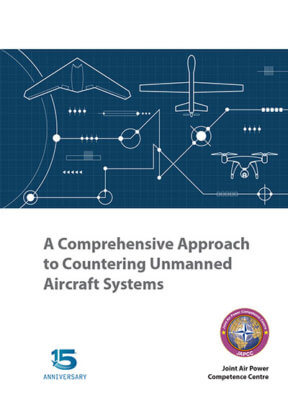Introduction
Unmanned Aircraft Systems (UAS) are part of daily life, from hobby enthusiasts and delivery companies to actual people/ groups with malevolent intentions, and also present a growing capability in armed conflicts. This circumstance gets amplified by the fact that Unmanned Aircraft (UA) are classified in various size/weight categories and may have a substantially different threat behaviour. Due to their omnipresence, Command and Control (C2) of C-UAS must be available from peacetime to conflict, which requires deconfliction between civilian and military responsibilities. The threat of UAS is significant, increasing and cannot be ignored. Due to the very nature of some UA, they will be detected quite late, which drastically reduces the available time to execute the kill-chain. Therefore, it is not sufficient to only have all the tools, like Air Defence (AD) systems, readily available to counter this threat, but also an intricate system of C2. This includes the appropriate sensors and C2 networks, which are necessary to maximize efficiency and actually bring the over-all system to life.
Command and Control for C-UAS in Peacetime
To fully describe the C2 situation for C-UAS, we need to distinguish between peacetime, crisis and conflict conditions, between military and civilian, but also national and NATO responsibilities and the class of UAi and the individual components of the UAS.ii
In peacetime, two C2 structures/processes, military and civilian are responsible for executing C-UAS operations. On the military side, safeguarding the integrity of Alliance members’ sovereign airspace is a continuous peacetime task contributing to NATO’s collective defence. The NATO Air Policing mission is carried out using the NATO Integrated Air and Missile Defence System (NATINAMDS), where the Supreme Allied Commander Europe (SACEUR) has the responsibility for the overall mission conduct. Allied Air Command (AIRCOM) oversees the NATO Air Policing mission with 24/7 C2 from two Combined Air Operations Centres (CAOCs), which are responsible for their respective areas of NATO European Territory (NET). When an incident is identified which threatens the integrity of NATO’s airspace, the CAOCs will order interceptor aircraft based on the location of the incident. NATO member nations provide the necessary aircraft and assets for the air policing of their own airspace, under SACEUR direction. Subordinate to the CAOCs, national military Control and Reporting Centres (CRCs) not only support the CAOCs with their air picture, but also control military air traffic, including the Quick Reaction Alert (QRA) (I),iii within their national airspace.
In contrast, the respective civilian Air Traffic Control (ATC) structure is quite flat. A certain ATC service is responsible for air traffic handling, coordinating with military or adjacent civilian ATC units and ensuring flight safety within their assigned airspace. In case of unauthorized flights within their airspace, they have no authority other than reporting the incident to the appropriate military agencies (CRC) or the police. Civilian ATC units do not have the capability to interrogate uncooperative aircraft or force them to alter their flight path. If necessary, the corresponding national military needs to support with official assistance.
NATO uses NATINAMDS to ensure the security of NATO nations’ airspace. All available sensor data is compiled within the CAOCs into an overall air picture, the so-called Recognized Air Picture (RAP). NATINAMDS includes a network for data transmission (e.g. RAP) and adequate tools to support the AD mission in general. New instruments like the Air Command and Control System (ACCS) or the Air Command and Control Information System (AirC2IS) aim to improve this capability. In the CRCs, national systems are employed as well (e.g. the German Improved Air Defence System [GIADS]). Since C-UAS is a mission that involves more than the air domain (i.e. targeting all components of the UAS), an overall Common Operational Picture (COP) is needed and being made available by NATO sensors, C2 tools and networks.
Air traffic participants have to be identified or have the responsibility to identify themselves by technical or procedural means. Identification Friend or Foe (IFF) transponders are a requirement for a certain subset of aircraft, so are two-way radios and regulated aircraft markings. Also, the airspace is organized by ATC means, which allows for better organization and identification. In addition, typically for smaller drones, national regulations and laws exist in order to deconflict drone flight areas from regular air traffic, civilian infrastructure and special events. If an aircraft’s action is constituting a military threat, which is difficult to determine, as defined by NATO and national regulations, agreed-upon military measures against the threat can be executed. If the aircraft is in a RENEGADEiv situation or in violation of national/ international laws without posing a civilian threat, the appropriate national civilian law enforcement agencies and appropriate military Airspace Control Authorities are in charge of solving the issue. This also applies to countering or addressing other components of the UAS, e.g. remote-pilot, data link or control station.
All these situations have one thing in common: the aerial object has to be detected and tracked by one or more sensors and subsequently classified and identified. Class I UA and drones, however, are characterized by a very small Radar Cross Section (RCS). In addition, they normally fly very low in areas with a lot of clutter (cities). That makes it very difficult for any airspace sensor to continuously detect and track them and therefore successfully execute C2. It can be difficult to distinguish between aircraft that do not appear on any higher level (e.g. CAOC or ATC) air picture or aircraft that appear only very shortly or sporadically due to low flight levels or size. For aircraft that never appear on the RAP, especially small Class I & II UAS, but are detected either visually or by other means of local authorities, national law enforcement has the task to deal with regulation violations. However, since the respective aircraft are very likely in the category low/slow/small, the measures can only be reactive or very localized. This also applies for countering or addressing other components of the UAS like its remote-pilot, data link or control station. Aircraft that only shortly or sporadically appear in the RAP in the CAOC will be checked by means of an air policing response. If local airspace violations are detected by ATC, local procedures are activated and the incident will be reported via a military CRC. In both cases, countering and addressing the other components of the UAS, such as the remote-pilot, data link or the control station, is the responsibility of national law enforcement authorities. Because of that circumstance, the military, ATC and law enforcement C2 architectures and systems need to have a feasible level of multilateral interoperability and certain automated information exchange mechanisms.
Since these processes, structures, sensors, interceptors and tools are designed to handle known regular and irregular manned air traffic participants and their unmanned equivalents, there need to be regulations about who is responsible for all aircraft which are currently not reflected in or do not abide by the rules. Overall, it is of the utmost importance that the different C2 channels interface seamlessly in real-time.
Deployed NATO forces in peacetime, like maritime task forces, will be part of NATO’s peacetime C2 structure. Here C-UAS operations will be limited to self-defence.
Command and Control for C-UAS in Crisis/Conflict
When circumstances dictate the transition from peacetime to crisis/conflict, it will have significant impact on air traffic and its control in the affected region or Joint Operation Area (JOA). The continuous use of civilian UAS will definitely have to be addressed to prevent unintended actions against non-threatening aircraft. In joint operations, NATO will stand up a Joint Force Air Component (JFAC) equipped and manned to conduct and support air operations as part of the joint force in the region. Depending on the intensity of the crisis/conflict, the civilian air traffic will be restricted and reduced to maximize air safety and minimize friendly force attrition. So, regional ATC C2 and NATO military C2 for air traffic control need to be clearly harmonized to maximize safety and minimize friendly attrition. This becomes very critical during the transition from peacetime, when NATO nations start to transfer military forces into NATO’s C2 structure and NATO starts executing the mission.
The military approach to counter UAS can be separated into offensive, defensive, active and reactive actions. In the construct of Defensive Counter-Air (DCA) and Integrated Air and Missile Defence (IAMD) operations, military force can be applied according to the Rules of Engagement (ROE) and as necessary for self-defence. In both cases, a clear hostile act or hostile intent needs to be present, or in the most extreme case ‘the absence of friendly behaviour’, to act with military force. Hostile intent in an environment with a large presence of friendly or neutral UA will be more complex to be unambiguously identified and must be well defined, coordinated and communicated before the mission starts. Otherwise, either collateral damage or the risk level for NATO forces might be disproportionally high. For UA that are within the coverage of IAMD systems, the JFAC can employ various forms of engagement zones like Fighter Engagement Zones (FEZ), Missile Engagement Zones (MEZ) or Short-Range Air Defence Zones (SHORADEZ). Here, the air battle will be conducted within NATO’s Air C2 construct, using current concepts, plans and tools like ROEs or Tactical Battle Management Functions (TBMF). In accordance with international law, NATO forces can always act in self-defence to protect NATO/NATO-led forces and personnel, when an attack is ongoing or imminent. Since a lot of Class II UAS threats (and a majority of Class I as well) are ad hoc, hardly show up consistently on the RAP and have to be dealt with in real-time, which leaves little room for a long C2 chain for engagement decisions. This means that the more time-critical the anticipated engagement decisions are, the lower the engagement authorities have to be delegated towards the actual shooter to be effective. Decision points to delegate engagement authorities have to be identified during the planning phase. For the UA that cannot be included in regular air battle decisions, covered by Weapon Control Status, ROE and TBMF, self-defence will have to be applied as the only alternative. This however implies that most C-UAS capable units for Class I and II defence have to be constantly in a higher alert state to cope with the constant threat that cannot be handled by higher C2 levels. This has direct impact on the defence design and emission control planning. In general, even in the regular air battle, the engagement authority for ad hoc threats, like smaller UA, might have to be delegated lower and earlier on compared to more predictable air threats. This could speed up engagement decisions, as dictated by the UA threat.
In smaller NATO missions, where land or maritime components are deployed independently, the C2 for C-UAS will be heavily dependent on self-defence, but otherwise has to be defined in accordance with the task and available capabilities within the mission construct.
For other UAS components, such as the data link, the C2 element or the operator, more C2 segments outside of the JFAC may be necessary. Since it requires special Electronic Warfare (EW) equipment to identify, analyze, interrupt or hijack a UAS data link, especially the more complex satellite or cell phone links, the appropriate C2 of these effects needs to be planned and coordinated via the EW element in the theatre component and effected via the Air Operations Directive (AOD) or the Air Tasking Order (ATO). Engaging or even identifying UAS operators or C2 elements during DCA operations is challenging and therefore needs to be dealt with either by Offensive Counter-Air (OCA) operations or with the support of other theatre components like the land, maritime or cyber component and most likely managed through a Joint Forces Command.
Command and Control Considerations for Deployed Forces
In general, three variations of the operational environment can occur: 1) the JOA encompasses all of NET, 2) the JOA is within a fraction of NET and 3) the JOA is outside of NET. In all three cases it is important to synchronize the C2 of the operational forces and the receiving region within the JOA and with bordering C2 systems/architectures, especially on the fringes of the JOA. Synchronizing with non-NATO C2 architectures might cause interoperability issues. All this needs to be considered during the operational planning process.
If the JOA is outside of NET as part of NATO crisis management, the necessary NATO C2 to engage UAS either within ROE or self-defence have to be coordinated with the host nation’s military and civil C2 elements. As a crucial part of operational planning, the activation of ROEs has to be closely negotiated with the host nation. Furthermore, the use of the Electro-Magnetic Spectrum (EMS) to control, capture or disrupt the UAS data link needs to be coordinated with national and potentially other non-hostile military entities as well. For necessary military action on the surface and in the cyber domain, NATO land, maritime and cyber C2 needs to be harmonized, as well. C-UAS operations in NET will continue as before, however, a close linkage to the Air C2 in the JOA needs to be established to foresee or coordinate an increased UAS threat for NET.
If the JOA is within a small fraction of NET, the corresponding crisis/conflict C2 elements also have to coordinate with the host nation’s military and civil C2 counterparts. In this case a closer coordination with NATO´s peacetime Air C2 structure needs to be maintained to have a seamless C-UAS coverage (within the IAMD spectrum) over the whole NET. The increased likelihood of ‘spillovers’ into NET needs to be taken into consideration and potentially the military augmentation of local law enforcement agencies outside, but close to the JOA and within NET should be planned for sure.
In case of a Major Joint Operation (MJO) that encompasses all of NET, NATO C2 will be responsible for the defence of the whole region. However, close coordination with civilian authorities to maintain civil air traffic where possible and to use civilian law enforcement capabilities to augment NATO and NATO nation’s military is necessary.
In all three cases, it is possible that components of the UAS (e.g. operator, C2 element, data link hubs) are not within the JOA, enemy territory or a NATO country. Since targeting these components might be necessary, the appropriate authorities need to be identified, potential operations deconflicted and a legal framework needs to be identified. This might encompass military, civilian, regional, national and local C2 structures.
General Issue of C-UAS Command and Control
One major issue with C-UAS C2 is the very small RCS and potentially low flight paths of a large subset of UA, since detection is key to start the C2 process. This leads to significant sensor coverage problems, hampering successful C-UAS C2. Like all other C2 constructs, the C2 for C-UAS operations is constantly evolving to cope with the always-evolving threat. However, C-UAS operations are joint and multi-domain by nature, so the corresponding C2 is quite complex. Timely information sharing between decision-makers and operators is key and it needs to be agreed who needs and gets which data for what purpose. However, the use of surveillance data for offensive operations against UAS segments lends itself to legal discussions between NATO nations and might require so-called ‘red-card holders’. Also, military-civilian information exchange in deployed situations, especially outside of NET, needs to be regulated. In general, the situational awareness of the UAS threat needs to be maximized with available real-time and non-real-time data. For example, equipping highly flexible SHORAD Man-Portable Air Defence Systems (MANPADS) with a Link-16 RAP increased their efficiency and effectiveness. Ideas like this could be applicable for C-UAS missions below the IAMD spectrum.
The more data from various sensors in the joint environment that is available and the more dynamic the opposing use of UAS will be (especially with small RCS and low flight profiles), the faster C-UAS C2 needs to be to produce decisions that will be relevant and effective. The implementation of Artificial Intelligence (AI) or deep learning processes might be beneficial to support C-UAS C2 for air picture interpretation and potential decision support. Again, it needs to be regulated and defined how machine supported C2 decisions can be used/implemented in C-UAS missions or if such tools only augment the current C2 process.
Conclusion
NATO has existing and functional C2 structures, processes, networks and tools that are capable of countering the traditional air and surface threats. Over the last decade, NATO developed and improved its C2 to counter evolving and emerging threats like ballistic missiles or threats from the cyber domain. The same needs to be done with C2 for C-UAS. For missions that fall into the realm of IAMD, available C2 seems sufficient, but UAS that are clearly not within the scope of IAMD or on the fringe areas, need to be reflected in a well-integrated C2 environment. Especially because the very nature of C-UAS makes it a joint and multi-domain issue, the associated C2 needs to take that into consideration to allow for the appropriate effects to be delivered in time. It needs to be evaluated, whether the structure, process, tools and network are fast enough to address the threat and minimize the risk.
The widespread use of UAS of all classes for civilian and military purposes complicates proper situational awareness and therefore accurate and timely reactions to a potential threat or to mitigate the risk. Regulations about the use of civilian UAS and military/ law enforcement authorities need to be robust in peacetime, crisis and conflict.
C-UAS as a military problem involves all levels of C2, from strategic decision-makers down to the individual warfighter. C-UAS C2 needs to ensure that all necessary information is available at all levels to allow vital decisions, especially final engagement decisions, to be made in time to be relevant. Lastly, the C-UAS C2 needs to be flexible enough to reflect the evolving multi-domain environment and all available and upcoming C-UAS systems.













